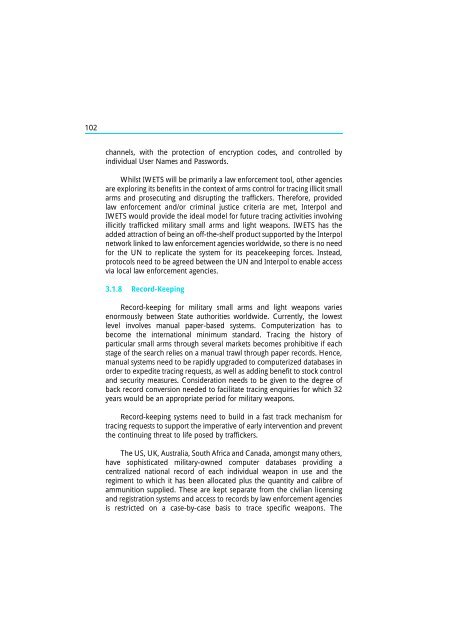The Scope and Implications of a Tracing Mechanism for Small Arms ...
The Scope and Implications of a Tracing Mechanism for Small Arms ...
The Scope and Implications of a Tracing Mechanism for Small Arms ...
Create successful ePaper yourself
Turn your PDF publications into a flip-book with our unique Google optimized e-Paper software.
102<br />
channels, with the protection <strong>of</strong> encryption codes, <strong>and</strong> controlled by<br />
individual User Names <strong>and</strong> Passwords.<br />
Whilst IWETS will be primarily a law en<strong>for</strong>cement tool, other agencies<br />
are exploring its benefits in the context <strong>of</strong> arms control <strong>for</strong> tracing illicit small<br />
arms <strong>and</strong> prosecuting <strong>and</strong> disrupting the traffickers. <strong>The</strong>re<strong>for</strong>e, provided<br />
law en<strong>for</strong>cement <strong>and</strong>/or criminal justice criteria are met, Interpol <strong>and</strong><br />
IWETS would provide the ideal model <strong>for</strong> future tracing activities involving<br />
illicitly trafficked military small arms <strong>and</strong> light weapons. IWETS has the<br />
added attraction <strong>of</strong> being an <strong>of</strong>f-the-shelf product supported by the Interpol<br />
network linked to law en<strong>for</strong>cement agencies worldwide, so there is no need<br />
<strong>for</strong> the UN to replicate the system <strong>for</strong> its peacekeeping <strong>for</strong>ces. Instead,<br />
protocols need to be agreed between the UN <strong>and</strong> Interpol to enable access<br />
via local law en<strong>for</strong>cement agencies.<br />
3.1.8 Record-Keeping<br />
Record-keeping <strong>for</strong> military small arms <strong>and</strong> light weapons varies<br />
enormously between State authorities worldwide. Currently, the lowest<br />
level involves manual paper-based systems. Computerization has to<br />
become the international minimum st<strong>and</strong>ard. <strong>Tracing</strong> the history <strong>of</strong><br />
particular small arms through several markets becomes prohibitive if each<br />
stage <strong>of</strong> the search relies on a manual trawl through paper records. Hence,<br />
manual systems need to be rapidly upgraded to computerized databases in<br />
order to expedite tracing requests, as well as adding benefit to stock control<br />
<strong>and</strong> security measures. Consideration needs to be given to the degree <strong>of</strong><br />
back record conversion needed to facilitate tracing enquiries <strong>for</strong> which 32<br />
years would be an appropriate period <strong>for</strong> military weapons.<br />
Record-keeping systems need to build in a fast track mechanism <strong>for</strong><br />
tracing requests to support the imperative <strong>of</strong> early intervention <strong>and</strong> prevent<br />
the continuing threat to life posed by traffickers.<br />
<strong>The</strong> US, UK, Australia, South Africa <strong>and</strong> Canada, amongst many others,<br />
have sophisticated military-owned computer databases providing a<br />
centralized national record <strong>of</strong> each individual weapon in use <strong>and</strong> the<br />
regiment to which it has been allocated plus the quantity <strong>and</strong> calibre <strong>of</strong><br />
ammunition supplied. <strong>The</strong>se are kept separate from the civilian licensing<br />
<strong>and</strong> registration systems <strong>and</strong> access to records by law en<strong>for</strong>cement agencies<br />
is restricted on a case-by-case basis to trace specific weapons. <strong>The</strong>
















